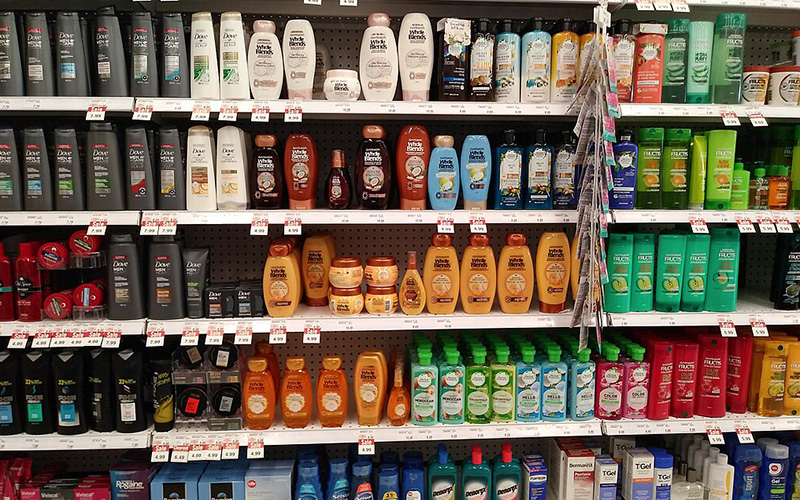When you design a cosmetic or soap label, the words on the front of your package do more than just look pretty. They inform your customer about the product, its maker, and why they should purchase it. That’s why it’s so important to understand the difference between product identity, product name, company name, and brand—which ones are required and how they work together on your label.
Let’s break this down with real examples, and then we’ll look at a common pitfall: using ingredient names in your product name.
Brand
Your brand is how customers recognize your products. It’s a unique name and, usually, a logo. These are items that can (and should be) trademarked to protect them. The brand is a unique and particular type of thing, separate from others of the same type. Nike® brand of shoes. Kleenex® brand tissues. MAC® brand of eye shadow. LUSH® brand bath bombs.
Usually, the brand, or at least the logo, is on the front of the package.
Business name and address
Your legal business name and address are required on the package, but they normally go on the back or side panel. Your legal business name is the name under which you file your taxes; it doesn’t have to be (and often isn’t) the same as your brand name.
Examples:
- Estee Lauder Companies, Inc. Brands: MAC, Clinque, Estee Lauder, etc.
- Burt’s Bees, Inc. Brands: Burt’s Bees
- Johnson & Johnson Consumer, Inc. Brands: Aveeno, Neutrogena, etc.
- Procter & Gamble. Brands: Pantene, Olay, Herbal Essences, Ivory, Old Spice, Secret, etc.
- Unilever. Brands: Dove, Suave, TRESemme, Ponds, etc.
Product Identity
Product identity is a required labeling element. It answers the question: What is this product?
The Fair Packaging and Labeling Act requires that every cosmetic (and most consumer commodities) state the product identity on the principal display panel (the front panel your customer sees first).
Examples of product identity:
- “Moisturizing Lotion”
- “Lip Balm”
- “Shampoo”
- “Soap”
It’s usually the common or usual name of the product, but it could also be a descriptive name, a fanciful name, or even an illustration — so long as it communicates what the product is.
Product Name?
The product name is what you, as the maker, choose to call that specific product. Unlike identity, it’s not required by law—but nearly every product has one.
It’s what distinguishes your lotion from that of another maker. Consider it this way – imagine sending your husband or wife to the store to get “shampoo.” Who knows what you’ll get. However, if you send them to get “Pantene PRO-V Smooth & Sleek Shampoo,” you can be fairly certain you’ll get back what you want.
The product identity and the product name CAN be the same thing, but you lose some of your potential marketing strength by doing so.
Examples:
- Pantene “PRO-V Smooth & Sleek Shampoo” → identity: shampoo; product name: PRO-V Smooth & Sleek
- Dr. Squatch “Fresh Falls Handmade Soap” → identity: soap; product name: Fresh Falls
- Lush “Magic Crystals Body Scrub” → identity: body scrub; product name: Magic Crystals
No Ingredient Names in the Product Name
Here’s where things can get tricky.
Under 21 CFR 701.1(b), a cosmetic is considered misbranded if the product name includes or suggests the name of one or more ingredients but not all ingredients.
Why? Because it can be misleading.
Imagine these examples:
- A lotion called “Shea Butter Cream” that also contains coconut oil, sunflower oil, and beeswax. The name suggests that shea butter is the main or only ingredient, which isn’t true.
- A soap labeled “Olive Oil Soap” that actually has more palm oil than olive oil. That could mislead customers into thinking olive oil is the base.
- A product called “Vitamin E Skin Oil” when vitamin E is only present at 0.1%.
These names highlight one ingredient as if it defines the product, when in fact the formula may include many others. That’s why the FDA considers it misleading.
You can mention ingredients elsewhere—just not as the product name.
For example:
- Instead of “Shea Butter Cream”, use “Moisturizing Body Cream” as the identity, then describe it as “made with shea butter and coconut oil” in the descriptive text.
- Instead of “Olive Oil Soap”, say “Soap” as the identity and mention “with olive oil” in the marketing copy.
- Instead of “Vitamin E Skin Oil”, call it “Skin Oil” and note on the back: “with nourishing vitamin E.”
Fragrance in the Product Name
Sometimes even putting the fragrance name in the product name can fall under this prohibition. When the fragrance name seems to be an ingredient, then you can easily slide into being misleading. This often happens when the product name and product identity are combined into one statement.
Examples of misleading product name statements, and alternatives that are much less misleading
| Prohibited Names | Appropriate Statements |
| Watermelon Soap | Watermelon scented soap |
| Oatmeal, Milk & Honey Soap | Handcrafted Soap Oatmeal, Milk & Honey scent |
| Strawberry Lotion | Body Lotion with Real Strawberries |
Putting It All Together
Of all these, only the product identity is required on the front, but for best marketing, the front label will usually show:
| Element | Example | Example |
| Brand name | Aveeno | MAC |
| Product name | Daily Moisturizing | Studio Fix |
| Product identity – REQUIRED | Body Lotion | Matte Foundation |
| Marketing Text | Fragrance Free | Oil Control |
| Business Name & Address – REQUIRED (back or side) | Johnson & Johnson Consumer, Inc | Estee Lauderf Companies |
Final Thoughts
Product identity, product name, and brand each serve a different purpose on your label. Identity tells customers what the product is, the product name tells them which one it is, and the brand tells them who made it.
Keeping those roles clear—and avoiding ingredient names as product names—helps ensure your labels are not only attractive but also legally compliant.


Leave a Reply